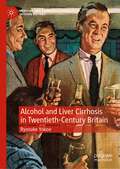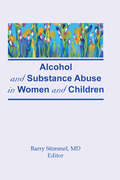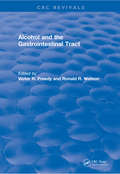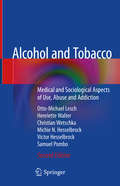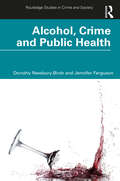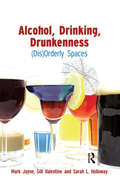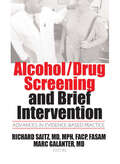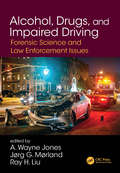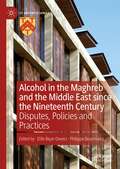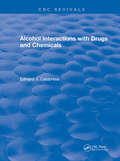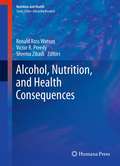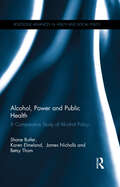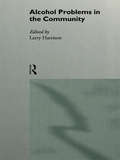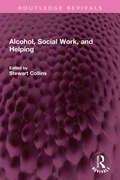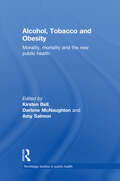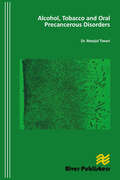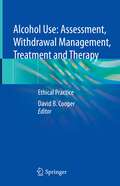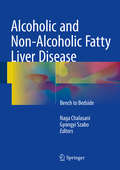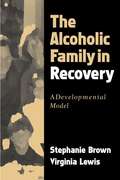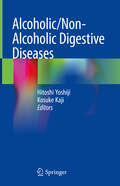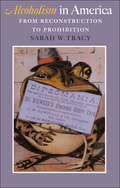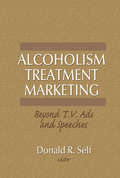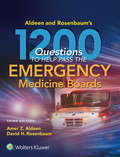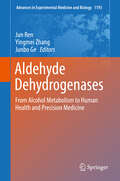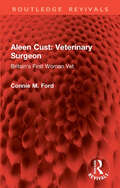- Table View
- List View
Alcohol and Liver Cirrhosis in Twentieth-Century Britain (Medicine and Biomedical Sciences in Modern History)
by Ryosuke YokoeThe relationship between alcohol consumption and liver cirrhosis has long been contested by doctors and medical professionals, creating numerous implications for the public reputation of alcohol in Britain. Despite this, it was not until the 1970s that cirrhosis came to be understood as an ‘alcoholic disease’. This book contextualises developments in this debate through the twentieth century by examining the significant influence that medical expertise had on policy responses to alcohol misuse, as well as the social reputation of alcohol consumption. It demonstrates how the degree to which drinking was seen to be responsible for liver disease directly shaped how different groups, such as the temperance movement and the drinks industry, exaggerated or downplayed the destructive properties of alcohol. Covering a series of themes including the science of disease causation, the social standing of medical expertise, and alcohol and public health policy, this book argues that in order to properly understand the trajectory of debates around drinking we need to consider the twentieth-century ‘alcohol problem’ as primarily a medical issue. Contrary to the tendency by existing works to disassociate perceptions and responses to alcohol use from the objective knowledge of its effects on the body, this book shows that medical understandings of liver disease influenced how alcohol was conceptualised in relation to its harms. Offering a fresh perspective on the interaction between scientific knowledge and policy during the twentieth century, this book provides insights for those researching the social, political and cultural history of modern Britain, as well as historians of medicine and health.
Alcohol and Substance Abuse in Women and Children
by Barry StimmelHere is a timely volume that examines the problems of substance abuse in women and children, with a particular emphasis on the role played by the family in the development and perpetuation of the problem.
Alcohol and the Gastrointestinal Tract (CRC Press Revivals)
by Victor R. PreedyThis book covers all aspects of gastrointestinal tract problems caused by alcohol misuse. Opening chapters discuss epidemiology and the metabolism of alcohol and the liver's role in that process. Alcohol and acetaldehyde dehydrogenases, free radicals, and endocrine changes are discussed in detail. Recent advances in the pathophysiology of alcohol-induced disorders are summarized and many chapters detail techniques such as permeability and protein synthesis. Effects on specific organs, including the salivary glands, stomach, pancreas, and small intestine, are also discussed. All contributors and both editors are internationally recognized experts in their fields.
Alcohol and Tobacco: Medical and Sociological Aspects of Use, Abuse and Addiction
by Otto-Michael Lesch Henriette Walter Christian Wetschka Michie N. Hesselbrock Victor Hesselbrock Samuel PomboThis updated and revised second edition of “Alcohol and Tobacco” reflects the new ICD 11 and DSM V classifications and provides comprehensive descriptions of new therapeutic approaches, outlining the different interactions between personality, environment and the effects of the respective substance. In addition to new data on prevention-based therapies, especially for smoking addiction, the book also presents essential psychological and sociological strategies, and medication-based therapies. Particular attention is given to new medications and new compounds for e-cigarettes, while a broad overview of the American and European epidemiology of alcohol and nicotine addictions rounds out the coverage. Given the breadth and depth of its coverage, the book will appeal to a wide readership, from professionals to researchers and students.
Alcohol, Crime and Public Health (Routledge Studies in Crime and Society)
by Dorothy Newbury-Birch Jennifer FergusonAlcohol, Crime and Public Health explores the issue of drinking in the criminal justice system, providing an overview of the topic from both a criminal justice and a public health perspective. The majority of prisoners in the UK (70%) have an alcohol use disorder, and evidence tells us that risky drinking is high amongst those in contact with all areas of the criminal justice system. Uniquely, this book brings both a criminal justice and a public health perspective to the topic. The book opens by exploring the levels of crime attributed to alcohol, the policy context of alcohol and crime, and the prevalence of risky alcohol consumption in the criminal justice system. The following chapters examine risky drinking amongst men, women and young people in the criminal justice system. The final chapters look at the efficacy of psychosocial interventions for risky drinking in the criminal justice system, and look forward to how researchers and practitioners can work together to produce research in the criminal justice system. Written in an accessible and concise style, Alcohol, Crime and Public Health will be of great use to students of criminology, criminal justice and public health as well as the wider area of public and social policy in relation to alcohol and crime.
Alcohol, Drinking, Drunkenness: (Dis)Orderly Spaces (Studies In Early Medieval Britain Ser.)
by Gill Valentine Sarah L. Holloway Mark JayneWhile disciplines such as anthropology, sociology, politics, social policy and the health and medical sciences have a tradition of exploring the centrality of alcohol, drinking and drunkenness to people's lives, geographers have only previously addressed these topics as a peripheral concern. Over the past few years, however, this view has begun to change, accelerated by an upsurge in interest in alcohol consumption relating to political and popular debate in countries throughout the world. This book represents the first systematic overview of geographies of alcohol, drinking and drunkenness. It asks what role alcohol, drinking and drunkenness plays in people's lives and how space and place are key constituents of alcohol consumption. It also examines the economic, political, social, cultural and spatial practices and processes that are bound up with alcohol, drinking and drunkenness. Designed as a reference text, each chapter blends theoretical material with empirical case studies in order to analyse drinking in public and private space, in the city and the countryside, as well as focusing on gender, generations, ethnicity and emotional and embodied geographies.
Alcohol/Drug Screening and Brief Intervention: Advances in Evidence-Based Practice
by Mark Galanter Richard SaitzGet a better understanding of what is known and what is not known in this widespread practice Screening and brief intervention (SBI) has been around for over 40 years and is a widely recognized practice. Alcohol/Drug Screening and Brief Intervention: Advances in Evidence-Based Practice provides a valuable exploration of the present literature, the effectiveness and cost-effectiveness of screening and brief intervention, and methodological challenges in studying these practices. Respected leaders in the field discuss ways to measure the use of screening and brief intervention in practice, the multiple risk factor context in which unhealthy alcohol use occurs, clinician training issues, effective strategies to screen adolescents, which patients are most likely to change from SBI, and what research is needed in the future. Screening and brief intervention are presently being used in numerous settings such as hospitals, primary care settings, trauma centers, and college health services. Alcohol/Drug Screening and Brief Intervention: Advances in Evidence-Based Practice examines in detail original research and cutting edge research issues in these settings to provide an important review of what is known and what is not known about the practice. Methodological issues are extensively discussed. This valuable book provides crucial information on the detection of small effects, standards of analysis, reporting, interpretation, the risks of bias, and the need to ensure that results have the potential to be applied in practice. Health professionals and addiction specialists get an important critical re-evaluation of the growing practice and are provided direction for future research. Other topics in Alcohol/Drug Screening and Brief Intervention: Advances in Evidence-Based Practice include: results of research on screening, brief intervention, and referral to treatment (SBIRT) exploration of data assessing the effectiveness of screening and brief alcohol intervention evaluation of clinical alcohol screening with the AUDIT-C cost-effectiveness and cost-benefit of SBI in medical settings research into SBIRT for Emergency Departments data on primary care patients with multiple risk factors research on feasibility and efficacy of "no-contact" interventions and more! Alcohol/Drug Screening and Brief Intervention: Advances in Evidence-Based Practice is essential reading for alcohol and drug researchers, screening and brief intervention program practitioners, physicians, nurses, health promotion advocates, Public Health Practitioners, and the State Departments of Public Health.
Alcohol, Drugs, and Impaired Driving: Forensic Science and Law Enforcement Issues
by A. Wayne Jones Jørg G. Mørland Ray H. LiuAlcohol, Drugs, and Impaired Driving addresses many theoretical and practical issues related to the role played by alcohol and other psychoactive drugs on driving performance, road-traffic safety, and public health. Several key forensic issues are involved in the enforcement of laws regulating driving under the influence of alcohol and/or other drugs, including analytical toxicology, pharmacology of drug action, as well as the relationships between dose taken, concentration levels in the body, and impairment of performance and behavior. Our knowledge of drunken driving is much more comprehensive than drugged driving, so a large part of this book is devoted to alcohol impairment, as well as impairment caused by use of drugs other than alcohol. For convenience, the book is divided into four main sections. The first section gives some historical background about measuring alcohol in blood and breath as evidence for the prosecution of traffic offenders. The important role of the Breathalyzer instrument in traffic-law enforcement, especially in Australia, Canada, and the USA is presented along with a biographical sketch of its inventor (Professor Robert F. Borkenstein of Indiana University) with focus on the man, his work and his impact. The second section discusses several issues related to forensic blood and breath-alcohol alcohol analysis as evidence for prosecution of traffic offenders. This includes how the results should be interpreted in relation to impairment and an evaluation of common defense challenges. Because most countries have adopted concentration per se laws, the main thrust of the prosecution case is the suspect’s measured blood- or breath-alcohol concentration. This legal framework necessitates that the analytical methods used are "fit for purpose" and are subjected to rigorous quality assurance procedures. The third section gives a broad overview of the current state of knowledge about driving under the influence of non-alcohol drugs in various countries. This includes adoption of zero-tolerance laws, concentration per se statutes, and clinical evidence of driver impairment based on field sobriety tests and drug recognition expert evidence. The fourth section deals with epidemiology, enforcement, and countermeasures aimed at reducing the threat of drunken and drugged driving. All articles have appeared previously in the international journal Forensic Science Review, but all are completely updated with current data, references, and the latest research on developments since the articles were published. This book contains a convenient collection of the best articles covering recommendations for blood and breath testing methods, public policy relating to such methods, and forensic and legal implications of the enforcement of measures to counter driving under the influence.
Alcohol in the Maghreb and the Middle East since the Nineteenth Century: Disputes, Policies and Practices (St Antony's Series)
by Elife Biçer-Deveci Philippe BourmaudThis book explores the significance of alcohol in the Middle East and Maghreb as a powerful catalyst of social and political division. It shows that the solidarities and polarities created by disputes over alcohol are built on arguments far more complex than oppositions on religion or consumption alone. In a region in which alcohol is banned by Islamic rules, yet allows its production and consumption, alcohol has always been contentious. However, this volume examines the different forms of social authority – religious, cultural and political – to offer a new understanding of drinking behaviours in the Middle East and North Africa. It suggests that alcohol, being at the same time an import and product of local industry, epitomises the tensions inherent to the conforming of Islamic societies to global trends, which seek to redefine political communities, social hierarchies and gender roles. The chapters challenge common misconceptions about alcohol in this region, arguing instead that medical discourses on alcohol dependency hide stances on national independence in an imperialist context; that the focus on religion also tends to conceal disputes on alcohol as a social struggle; and that disputes on inebriation are more about masculinity than judging private leisure. In doing so, the volume presents alcohol as a way of grasping the power relations that structure the societies of the Middle East and Maghreb.
Alcohol Interactions with Drugs and Chemicals (CRC Press Revivals)
by Edward J. CalabreseAlcohol Interactions with Drugs and Chemicals is a concise volume that identifies, documents, and assesses the capacity of alcohol to alter the toxicity of chemical pollutants and drugs in animal models and humans. The book systematically assesses interactions according to general chemical classes of inorganic and organic agents. It also presents an integrative discussion of the significance of these findings to public health.Alcohol Interactions with Drugs and Chemicals will be a valuable reference tool for environmental scientists, toxicologists, epidemiologists, and alcohol researchers studying the interactions of alcohol with drugs and chemical pollutants.
Alcohol, Nutrition, and Health Consequences (Nutrition and Health)
by Victor R. Preedy Ronald Ross Watson Sherma ZibadiChronic alcohol use is associated with heart, liver, brain, and other organ pathology. Alcohol is a drug of abuse and a caloric food and it causes poor intake and absorption of nutrients, thus playing a major role in many aspects of clinical consequences. Alcohol use lowers consumption of fruit and vegetables, lowers tissue nutrients, and, in some cases, requires nutritional therapy by clinicians. Alcohol, Nutrition, and Health Consequences will help the clinician define the causes and types of nutritional changes due to alcohol use and also explain how nutrition can be used to ameliorate its consequences. Chapters present the application of current nutritional knowledge by physicians and dietitians. Specific areas involving alcohol-related damage due to nutritional changes are reviewed, including heart disease, obesity, digestive tract cancers, lactation, brain function, and liver disease. In addition, alcohol's effects on absorption of minerals and nutrients, a key role in causing damage are treated. The importance of diet in modifying alcohol and its metabolite damage is also explained. Alcohol, Nutrition, and Health Consequences is essential reading for alcohol therapists and researchers as well as primary care physicians and dietitians and is an easy reference to help the clinician, student, and dietitian comprehend the complex changes caused by direct and indirect effects of ethanol at the cellular level via its nutritional modification.
Alcohol, Power and Public Health: A Comparative Study of Alcohol Policy
by Shane Butler Betsy Thom James Nicholls Karen ElmelandIn recent years, the reduction of alcohol-related harm has emerged as a major policy issue across Europe. Public health advocates, supported by the World Health Organisation, have challenged an approach that targets problem-drinking individuals, calling instead for governments to control consumption across whole populations through a combination of pricing strategies, restrictions on retail availability and marketing regulations. Alcohol, Power and Public Health explores the emergence of the public health perspective on alcohol policy in Europe, the strategies alcohol control policy advocates have adopted, and the challenges they have faced in the political context of both individual states and the European Union. The book provides a historical perspective on the development of alcohol policy in Europe using four case studies – Denmark, England, Scotland and Ireland. It explores the relationship between evidence, values and power in a key area of political decision-making and considers what conditions create – or prevent – policy change. The case studies raise questions as to who sets policy agendas, how social problems are framed and defined, and how governments can balance public health promotion against both commercial interests and established cultural practices. This book will be of interest to academics and researchers in policy studies, public health, social science, and European Union studies.
Alcohol Problems in the Community
by Larry HarrisonCommunity surveys reveal that about 6% of the adult male and 1% of the adult female population in England and Wales are drinking at high risk levels. Alcohol Problems in the Community examines the implications of recent community care legislation for government policy on alcohol. The first part of the book begins with a report on recent US research on the role of alcohol in the perpetration of child abuse and recent research on young people's drinking problems. This is followed by a study on the prevalence of drinking problems amongst older people which has been underestimated. In the second half of the book empirical evidence is presented on the particular difficulties faced by ethnic, migrant and homeless groups and this emphasis on the centrality of social disadvantage leads on to a consideration of a specific social work role in the assessment and management of alcohol-related problems. Alcohol Problems in the Community is aimed at social work practitioners and students on prequalifying, qualifying and postqualifying social work courses, and it addresses key social work issues in relation to poverty, homelessness, discrimination and drinking problems.
Alcohol, Social Work, and Helping (Routledge Revivals)
by Stewart CollinsFirst published in 1990, Alcohol, Social Work and Helping provides coherent and imaginative advice on how to counsel the growing number of clients whose use of alcohol causes of problems. It locates intervention within societal and agency contexts and tackles such practical issues as: how to work with a problem drinker; which short-term goals to suggest; what kind of help to apply; and how to assist in the event of a relapse. The contributors, with backgrounds in academic, statutory, and voluntary settings, focus on key areas of intervention, family, and group contexts, and there is a chapter on the particular circumstances and needs of women. All relevant information – both general and specialized – is presented in a clear, easy-to-read style, and is aimed at developing existing knowledge and skills. This book will be of interest to students of health, social work, and sociology.
Alcohol, Tobacco and Obesity: Morality, mortality and the new public health
by Amy Salmon Kirsten Bell Darlene McNaughtonAlthough drinking, smoking and obesity have attracted social and moral condemnation to varying degrees for more than two hundred years, over the past few decades they have come under intense attack from the field of public health as an 'unholy trinity' of lifestyle behaviours with apparently devastating medical, social and economic consequences. Indeed, we appear to be in the midst of an important historical moment in which policies and practices that would have been unthinkable a decade ago (e.g., outdoor smoking bans, incarcerating pregnant women for drinking alcohol, and prohibiting restaurants from serving food to fat people), have become acceptable responses to the 'risks' that alcohol, tobacco and obesity are perceived to pose. Hailing from Canada, Australia, the United Kingdom and the USA, and drawing on examples from all four countries, contributors interrogate the ways in which alcohol, tobacco and fat have come to be constructed as 'problems' requiring intervention and expose the social, cultural and political roots of the current public health obsession with lifestyle. No prior collection has set out to provide an in-depth examination of alcohol, tobacco and obesity through the comparative approach taken in this volume. This book therefore represents an invaluable and timely contribution to critical studies of public health, health inequities, health policy, and the sociology of risk more broadly.
Alcohol, Tobacco and Oral Precancerous Disorders
by Munjul TiwariIt is estimated that in India 75% of cancers of oral cavity are attributable to tobacco chewing, smoking and alcohol drinking. So the purpose of this book is to present the correlations of these premalignant disorders microscopically with in tobacco users and alcohol drinkers.
Alcohol Use: Ethical Practice
by David B. CooperThe book brings together the most up-to-date knowledge and expertise covering the whole topic of alcohol. It presents the practical skills needed to offer ethical intervention and treatment and implement ethical person-centered care. It is a practice-based text that aims to improve ethical relationships, responses, care and practice necessary to be effective in interventions and treatment with those experiencing alcohol use and health problems. The focus is on combining the principles and philosophy of alcohol prevention and intervention, in hospital and community. Each chapter provides self-assessment exercises, reflective practice exercises, key points and a "to learn more" section, and develops a theoretical framework, before broadening to include application in care and practice. This work will appeal to a wide readership, from professionals working within the mental health care and practice environment to mental health students.
Alcoholic and Non-Alcoholic Fatty Liver Disease: Bench to Bedside
by Naga Chalasani Gyongyi SzaboThis volume is the first text to concisely yet comprehensively cover developments for both alcoholic and nonalcoholic fatty liver disease in an organized fashion. Aspects of these two diseases covered in the book include global epidemiology and risk factors, pathogenesis, animal models, hepatic and extra-hepatic malignancies, treatment models, and current and emerging therapies. Written by experts in the field, Alcoholic and Non-Alcoholic Fatty Liver Disease: Bench to Bedside is a valuable resource for gastroenterologists, pathologists, and hepatologists who treat patients with alcoholic and nonalcoholic fatty liver disease.
Alcoholic Family in Recovery
by Stephanie Brown Virginia M. LewisMost treatments for alcoholism have focused on abstinence as their final goal and emphasize brief interventions with the addicted individual. But family relationships change dramatically when the alcoholic stops drinking in fact, stress, turmoil, and uncertainty are the norm. This volume details how to help families regroup after abstinence, ride out periods of emotional upheaval, and find their way to establishing a more stable, yet flexible, family system. Using a compelling case-study format to illustrate the process of change, the book presents the moving personal experiences of families at different stages of the recovery process. Expanding the therapist's role to include psychoeducation and supportive counseling, the authors provide pointers for assessment at key stages of recovery and guide clinicians through bringing about lasting change.
Alcoholic/Non-Alcoholic Digestive Diseases
by Hitoshi Yoshiji Kosuke KajiThis book describes the latest advances concerning the molecular mechanisms of and therapeutic strategies for alcohol- and non-alcohol-related digestive diseases. Alcohol abuse causes not only liver injury but can harm various organs, resulting in esophageal and colorectal cancers, GERD, pancreatitis, etc. Similar to alcoholic abuse, metabolic syndrome based on obesity and diabetes is also strongly associated with the development of various digestive diseases. Although these diseases may be differentiated by the presence or absence of alcohol intake, the pathologic findings and pathogenesis reveal a number of similarities. This volume covers clinical and basic approaches for esophageal, gastric, hepatic, colorectal and pancreatic diseases associated with alcohol abuse and metabolic syndrome; further, it discusses the roles of microbiota, oxidative stress, and apoptosis, the critical factors causing alcoholic and metabolic digestive diseases. Also, it showcases new pathological and therapeutic perspectives in gastric and pancreatic cancers. Alcoholic/Non-Alcoholic Digestive Diseases will provide invaluable information for doctors specializing in gastroenterology and hepatology and researchers seeking new research on digestive diseases based on alcohol consumption and obesity.
Alcoholism in America: From Reconstruction to Prohibition
by Sarah W. TracyDespite the lack of medical consensus regarding alcoholism as a disease, many people readily accept the concept of addiction as a clinical as well as a social disorder. An alcoholic is a victim of social circumstance and genetic destiny. Although one might imagine that this dual approach is a reflection of today's enlightened and sympathetic society, historian Sarah Tracy discovers that efforts to medicalize alcoholism are anything but new.Alcoholism in America tells the story of physicians, politicians, court officials, and families struggling to address the danger of excessive alcohol consumption at the turn of the century. Beginning with the formation of the American Association for the Cure of Inebriates in 1870 and concluding with the enactment of Prohibition in 1920, this study examines the effect of the disease concept on individual drinkers and their families and friends, as well as the ongoing battle between policymakers and the professional medical community for jurisdiction over alcohol problems. Tracy captures the complexity of the political, professional, and social negotiations that have characterized the alcoholism field both yesterday and today.Tracy weaves American medical history, social history, and the sociology of knowledge into a narrative that probes the connections among reform movements, social welfare policy, the specialization of medicine, and the social construction of disease. Her insights will engage all those interested in America's historic and current battles with addiction.
Alcoholism Treatment Marketing: Beyond T.V. Ads and Speeches
by Donald SelfThe annual economic burden of alcohol abuse in the United States is staggering, yet the alcoholism treatment industry has been historically plagued by governmental regulations, moral crusades, advocacy of specific treatment approaches, and a lack of marketing knowledge. Here is the first focused set of research on the marketing of alcoholism treatment services. The authors of this much-needed volume--reputable marketing and research scholars--greatly expand the current base of knowledge concerning the alcohol treatment marketing subdiscipline, including the referral system analyses of market potentials for providers, promotional effort consultation for new providers, and the evolving nature of medical services distribution systems. Through in-depth interviews with treatment providers, referral sources, and former clients of treatment facilities, and in major reviews of literature on the subject, Alcoholism Treatment Marketing presents primary research and general research findings to provide practical marketing implications.
Aldeen and Rosenbaum's 1200 Questions to Help You Pass the Emergency Medicine Boards
by Amer Aldeen David H. RosenbaumFully revised and updated based on valuable reader feedback, Aldeen and Rosenbaum's 1200 Questions to Help You Pass the Emergency Medicine Boards, Third Edition gives you the tools you need to pass the ABEM board exam on the first try. Questions are slightly more difficult than the average exam question, in order to challenge and add to your knowledge and fully prepare you for questions you’re likely to see. Every question in this Third Edition has been reviewed for quality and relevance, ensuring that this unique study tool is an ideal choice to prepare for both the in-service residency exam and the board exam in emergency medicine.
Aldehyde Dehydrogenases: From Alcohol Metabolism to Human Health and Precision Medicine (Advances in Experimental Medicine and Biology #1193)
by Jun Ren Yingmei Zhang Junbo GeThis volume covers the science of ALDH enzymes in relation to chronic disease processes and the future therapeutic potentials of targeting ALDH in these processes. It thoroughly reviews the roles of ALDH family in alcohol metabolism, as well as recent findings of their emerging roles in a variety of human pathologies such as cardiovascular diseases, diabetes, obesity, stroke, cancer, liver diseases and kidney diseases. Delicate contribution of ALDH enzymes in the therapeutics against chronic diseases is also discussed. It demonstrates the unique value of targeting genetic polymorphism in ALDH enzymes in personalized medicine. The book will appeal to scientists, physicians, graduate and professional students in the fields of ALDH enzymes, alcohol metabolism, cardiometabolic and other chronic diseases. Pharmaceutical and other companies developing new tools for cardiometabolic and chronic diseases treatment will also find this a valuable resource.
Aleen Cust Veterinary Surgeon: Britain's First Woman Vet (Routledge Revivals)
by Connie M. FordOriginally published in 1990, this book is a valuable contribution to the history of the veterinary profession in Great Britain and Ireland. Connie Ford’s book is a reminder of the great social changes that have taken place since Aleen Cust was born in 1868. When Aleen Cust entered the New Veterinary College, Edinburgh in 1895, and was later refused permission to sit the examinations of the Royal College of Veterinary Surgeons, no British woman had the vote. To the women students, only admitted to the London Veterinary College in 1927, she was a legend and an example. Now, a new generation of veterinarians, will find this account of the life and times of a truly remarkable woman a revelation.
